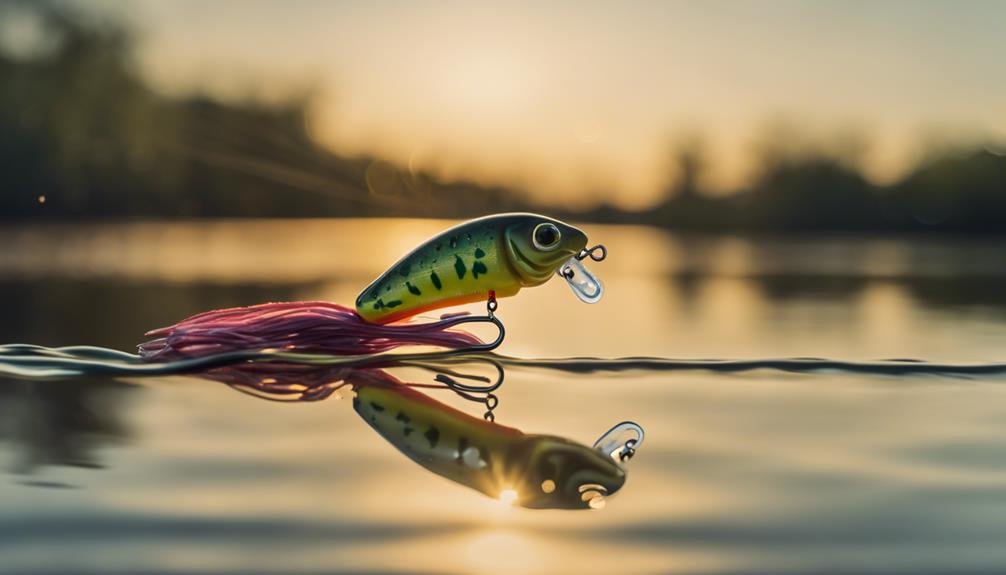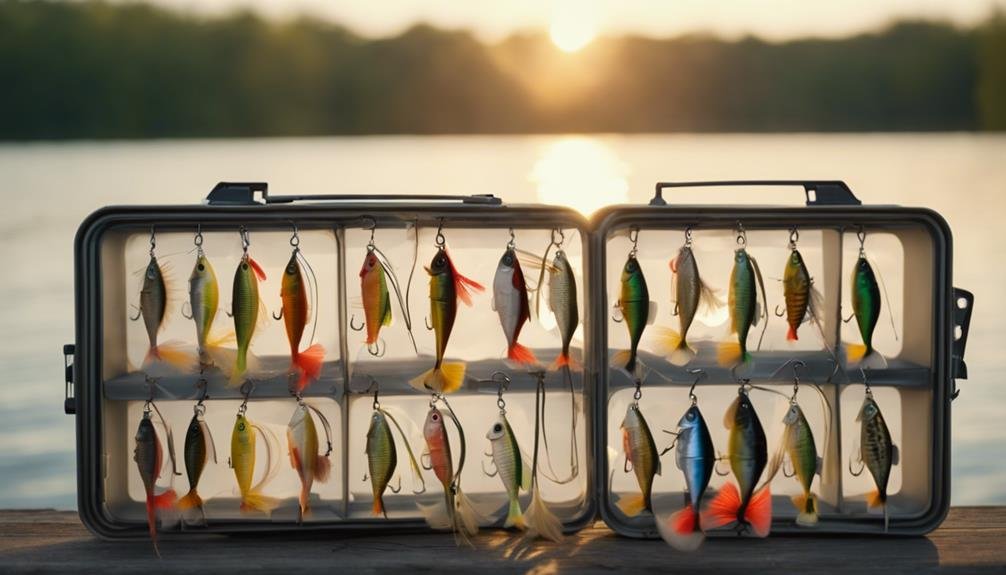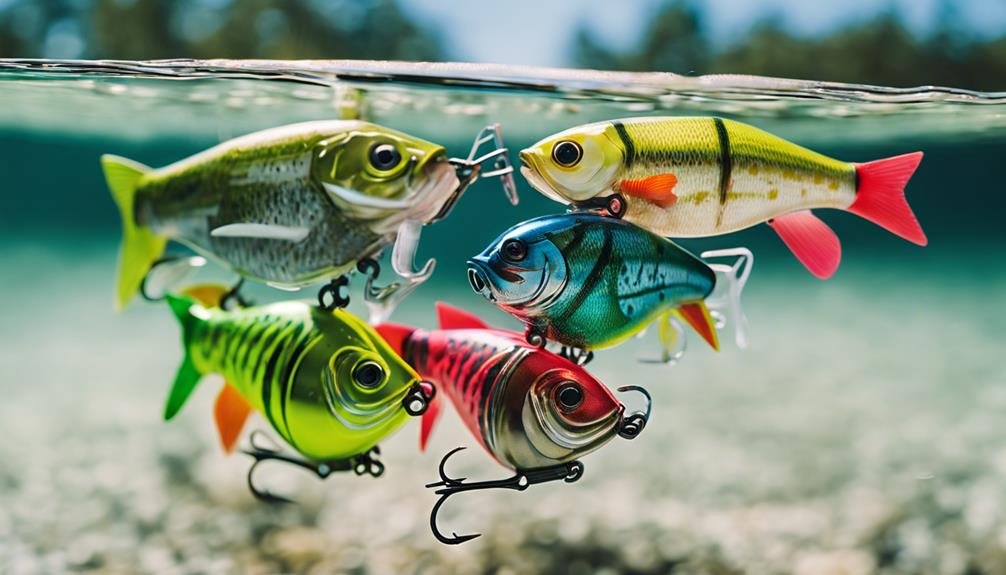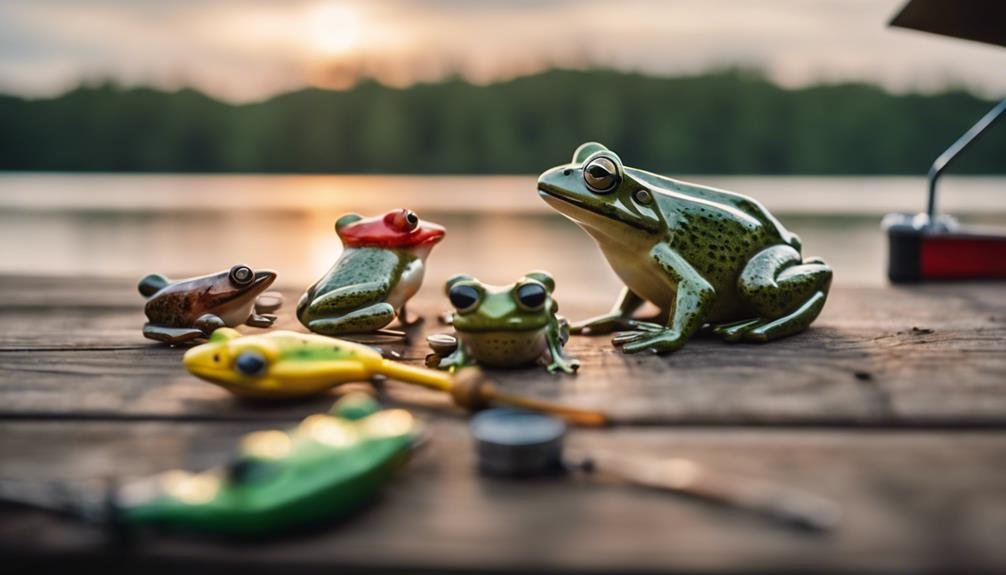When you’re gearing up for a day of bass fishing, picking the right lure can dramatically impact your success. You might be wondering if there’s a single best lure for all conditions, but the truth is that the effectiveness of each lure can vary based on water clarity, temperature, and the bass’s feeding habits. For instance, soft plastic worms work wonders in murky waters, while crankbaits are ideal in clearer waters. Now, you may ask, what about spinnerbaits or topwater lures? Let’s say each has its secret for attracting bass that could change how you fish. Curious to find out more?
Key Takeaways
- Soft plastic stick baits are essential for mimicking live prey and covering large water areas effectively.
- Spinnerbaits are versatile, suitable for navigating weeds and rocks, and trigger reaction strikes with their vibration and flash.
- Skirted bass jigs are ideal for navigating through thick cover and enticing bass with lifelike movements.
- Topwater lures provide exhilarating strikes, especially effective in the early morning or late afternoon.
- Crankbaits, like the Norman DD 22, are great for reaching deeper water levels where big bass lurk.
Essential Lure Types

When targeting bass, selecting the right lure is crucial; here are five essential types you should know.
First, soft plastic stick baits are your go-to for covering large water areas. They’re versatile and allow long casts, so you can reach that distant bass without spooking them.
Curl Tail Grubs, known for their adaptability, are a favorite among bass anglers. They can be used in various techniques, whether jigging or using them as trailers.
Next, consider spinnerbaits when you’re fishing over hardcover like timber. Their unique design and movement create vibrations and flashes that are irresistible to bass.
Then, with their erratic movements as they deflect off the cover, Square Bill Crankbaits is perfect for enticing bass. These lures are ideal for fishing close to obstructions where bass like to hide.
Lastly, don’t forget about Skirted Bass Jigs. They offer unmatched versatility in different fishing scenarios. Whether flipping them into tight spots or dragging them along the bottom, these jigs are a staple for any bass angler’s toolkit.
With these lures, you’ll be well-equipped to tackle various bass fishing challenges.
Topwater Lures Explained
Now, let’s explore topwater lures, which are highly effective during warm, active bass months. These lures are best used in the early morning or late afternoon when bass are on the prowl. The thrill of topwater fishing comes from seeing bass explode on your lure at the surface, providing an effective technique and an exhilarating experience.
Topwater lures excel around:
- Vegetation: Cast near lily pads or weedy margins where bass hide. The lure’s action mimics vulnerable prey.
- Structure: Approach docks, fallen trees, and submerged objects. Bass uses these as ambush points, waiting to strike unsuspectingly.
- Open Water: Even in less cluttered areas, topwater lures can attract bass looking for an easy meal on calm days.
Experimenting with the retrieval speed of your topwater lure can greatly increase your strikes. Slower retrieves can be tantalizing, while faster ones might incite aggressive attacks from the bass.
Always watch the weather; a slight breeze or overcast conditions often enhance topwater lure performance by disguising your lure and encouraging bass to venture out from cover. So, grab your gear and head out; it’s time to witness those spectacular topwater strikes for yourself!
Understanding Spinnerbaits

To master bass fishing, you’ll need to understand how spinnerbaits work. They’re essential tools for enticing bass in various environments. Spinnerbaits are versatile lures uniquely designed with a wire frame, spinning blades, and a skirted hook that mimics injured baitfish. This design creates a compelling vibration and flash that trigger reaction strikes from the bass.
Spinnerbaits shine in various conditions. Whether casting in shallow cover or exploring open water, these lures can navigate around weeds and rocks where bass hide without getting snagged. This makes them a top choice for anglers facing diverse water scenarios.
You can customize these lures to suit specific situations by choosing different blade combinations, colors, and sizes. Adjusting the blades alters the vibration and flash, helping you match the lure more closely with the natural prey of bass in different waters. For example, larger blades generate more vibration, making them ideal for murky water.
Mastering the retrieval techniques such as slow rolling, burning, or yo-yo-ing enhances the effectiveness of spinnerbaits. Each technique varies the lure’s movement through the water, helping you cover different depths and enticing bass to strike under varying aquatic conditions.
The Role of Soft Plastics
Soft plastics have become a game-changer in bass fishing, offering unique textures and movements that mimic live prey effectively. You’ll find that these lures aren’t just versatile; they’re essential in your tackle box if you’re aiming to catch that elusive big bass. Among the best bass lures, soft plastics like the Yamamoto Senko stand out due to their weighted plastics, which provide a seductive fall action that bass often can’t resist.
Consider how these renowned soft plastics make a difference:
- Gene Larew Salt Craw: Incorporates salt technology to enhance flavor, making it irresistible to bass.
- Lunker City Slug-Go: A pioneer among soft jerk baits, its erratic movements trigger aggressive reaction strikes.
- Manns Jelly Worm: The classic plastic worm continues to dominate with its appealing colors and textures, proving essential for targeted fishing.
These lures, including the Z-Man TRD, specifically appeal to heavily-pressured bass, offering a subtler approach that can be the key to success in crowded waters. Whether casting in a tranquil lake or a bustling river, integrating soft plastics into your strategy boosts your chances of a rewarding catch. So, don’t overlook the power of soft plastics; they might be the secret weapon you need.
Crankbaits for Depth

While soft plastics are adept at mimicking live prey, crankbaits offer the advantage of reaching bass at various depths, including those beyond 15 feet. Crankbaits shine when you’re targeting deeper waters, where their ability to dive and wobble entices bass lurking below. One standout is the Norman DD 22, a deep-diving crankbait that’s clinched countless tournament wins. Its design allows it to reach depths over 15 feet, making it ideal for exploring those hard-to-reach spots where bass hide.
Another versatile option you’ve got is the Bill Lewis Rat-L-Trap. Although it’s a lipless crankbait, it’s exceptionally effective at various depths, depending on your retrieval speed. This makes it a top choice for quickly covering a lot of water, whether you’re fishing deep or shallow.
Don’t overlook the Fred Young Big O. For shallower areas, This hand-carved balsa crankbait excels at maneuvering through cover and bouncing off obstacles, making it perfect for enticing bass in more complex structures without snagging.
Lastly, the Zorro Aggitator Spinnerbait, although not a crankbait, complements your deep-water arsenal by offering a snag-proof option for fishing over cover. It’s a favorite among competitive anglers for its effectiveness in tricky spots.
Jigs and Their Uses
Jigs are a must-have in any bass angler’s arsenal, renowned for their ability to navigate through thick cover and tempt bass with their lifelike movements. The weedless design of jigs lets you confidently fish around structures like logs, brush, and rocks. Their ability to penetrate heavy cover can be the key to reaching bass that other lures simply can’t. Whether you’re flipping, casting, or pitching, the versatile jig is designed to handle it all.
Here’s what makes jigs so effective:
- The lead head sinks swiftly, allowing jigs to reach deeper waters where big bass lurk.
- A skirt, typically made from silicone or rubber, flares out to mimic the appearance of a prey fish or crawfish.
- Adding trailers such as plastic craws or worms enhances the jig’s visual appeal and adds a tantalizing action that bass find irresistible.
Choosing the Right Frog Lure

When selecting the right frog lure for bass fishing, consider the SPRO Bronzeye Frog, which is renowned for its effectiveness in various aquatic environments. This frog lure is designed to produce significant results, especially when targeting big bass. Its lifelike appearance and unique way of mimicking a real frog’s movement make it a top choice in heavy cover and dense vegetation.
The SPRO Bronzeye Frog excels in topwater scenarios, an essential feature when bass feed aggressively. Its variety in sizes and colors allows you to match the frog lure to the conditions, increasing your chances of triggering those exciting, aggressive strikes. Here’s a quick guide to help you choose the best option for your next fishing trip:
| Feature | Benefit |
|---|---|
| Lifelike Design | Mimics real frog attracts big bass |
| Various Sizes | Suitable for different water bodies |
| Color Options | Match with the natural environment |
| Topwater Action | Effective in heavy cover |
Seasonal Lure Varieties
Understanding the seasonality of lure choices is key to optimizing your bass fishing success throughout the year. As temperatures and behaviors change, so should your tackle box contents. Here’s how you can adjust your strategy with the seasons:
You’ll find bass in deeper, colder water in winter’s icy grip. This is the time to slow things down with:
- Jigging spoons that mimic the movement of lethargic fish
- Soft plastic stick baits in subdued colors like green pumpkin
- Texas-rigged worms that can be worked slowly to entice sluggish bass
Spring brings warmer waters and active bass, ready to feed before the spawn. Shift to:
- Lipless crankbaits that can cover water quickly and trigger pre-spawn strikes
- Jerkbaits in bright or natural fish patterns, offering erratic action
Summer heat pushes bass towards shaded or deeper waters. Maintain your edge with:
- Soft plastic lures like worms and lizards, which can dive deep and tempt bass hiding from the sun
As fall sets in and temperatures dip, bass move shallower, chasing baitfish. This seasonal change calls for:
- Spinnerbaits and lipless crankbaits that mimic fleeing prey
- Crankbaits that dive to the mid-water levels where bass are likely feeding
Advanced Lure Techniques

Incorporate advanced lure techniques like the stop-and-go retrieve with crankbaits to elevate your bass fishing game. This method isn’t just about throwing your line out and hoping for the best; it’s about strategic movement. You’ll want to jerk the rod to make the lure dive and pause briefly, mimicking wounded prey that bass find irresistible.
When you’re dealing with murky waters, opt for rattling crankbaits. Their noise and vibration are key in attracting bass that can’t rely on sight alone.
However, when fishing in clear, open water, your color selection and lure size become vital. Choose smaller crankbaits in subtle colors to blend seamlessly into the environment, reducing fish wariness. This tactic is particularly effective with soft plastic lures, which can be rigged to enhance the natural presentation.
Remember to suspend jerk baits. These artificial lures are fantastic for targeting deeper water where bass hold during colder months. By allowing the jerk bait to pause mid-water, you mimic dying fish, a prime meal for a lurking bass.
Lure Selection Tips
Choosing the appropriate lure color to match the water conditions can greatly enhance your bass fishing success. When you’re selecting your lure, always take into account the watercolor. Clear waters call for transparent lures or those that closely mimic natural prey. However, you’ll want to switch to brighter or even vibrating lures in murky or discolored waters to attract the bass’s attention.
Here’s a quick guide to help you visualize the best choices:
- Clear Water: Opt for transparent or natural-colored lures that blend seamlessly with the environment.
- Murky Water: Choose vibrant or fluorescent lure colors and those that produce vibrations.
- Windy Conditions: Use heavier lures to maintain control and improve casting accuracy.
Additionally, don’t forget to consider the weather. In colder conditions, bass mightn’t be as active, so offering them a bigger meal with larger lures could be more enticing. Conversely, during the summer, long casts with natural-looking lures can significantly boost your chances of success. Remember, the key is to adapt your lure selection to both the environmental conditions and the seasonal behavior of bass to maximize your fishing outings.
Conclusion
Now, you’ve got the scoop on the top lures for bass fishing. Whether you’re skimming topwater lures over lily pads at dawn or tempting hidden bass with a well-placed crankbait, each type plays a pivotal role.
Mixing up your approach with different lures can elevate your game. So, keep these tips in mind, choose your lure wisely, and you’re all set to enjoy thrilling battles with some monster bass!
Happy fishing!
FAQs
Which lure is best for beginner bass anglers?
Soft plastic stick baits are highly recommended for beginners due to their versatility and ease of use. They effectively mimic live prey and allow for long casts, making them ideal for covering large water areas without spooking bass.
What lure works best in murky waters?
Soft plastic worms are a go-to choice in murky waters. Their lifelike appearance and subtle movements attract bass even in low visibility conditions. With its salt-enhanced flavor, the Gene Larew Salt Craw is particularly effective in enticing bass in murky waters.
When is the best time to use topwater lures for bass fishing?
Topwater lures are most effective during warm, active months when bass feed near the surface. Early morning or late afternoon are prime times for topwater action, as bass are more likely to strike aggressively. Experimenting with retrieval speed and adjusting to weather conditions can enhance their effectiveness.

